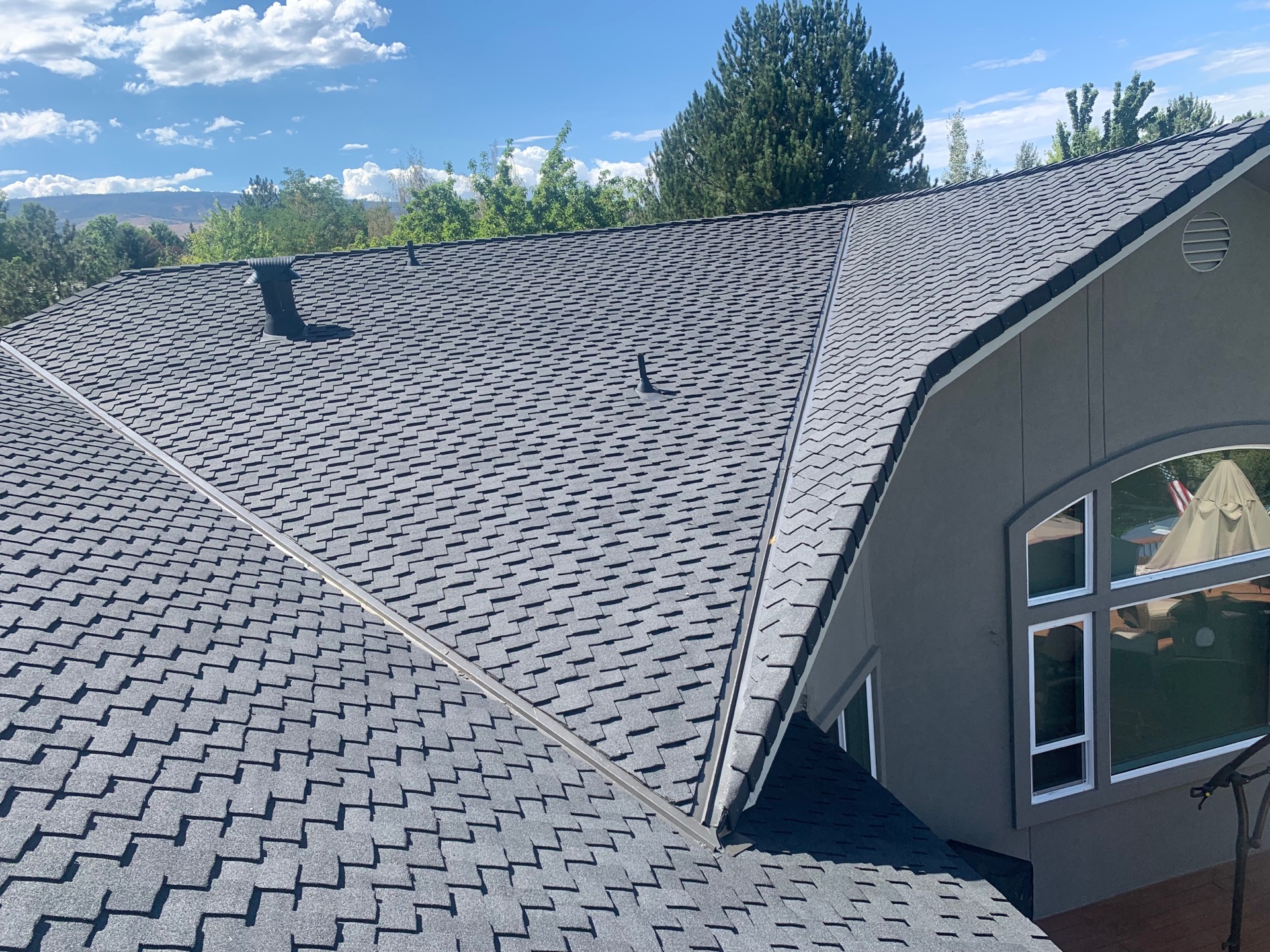Essential Inquiries to Ask Gainesville Roofing Companies Prior To Employing
Essential Inquiries to Ask Gainesville Roofing Companies Prior To Employing
Blog Article
Finest Practices for Ensuring Correct Roof Air Flow
Guaranteeing correct roof covering air flow is important for the long life and efficiency of a roofing system. A well balanced intake and exhaust vent ratio, frequently 1:300, plays a crucial function, with intake vents preferably positioned at the lower edge of the roof covering for cool air entry and exhaust vents at the optimal for warm air departure. Routine evaluations to identify blockages and preserve clear air flow are vital. Additionally, keeping insulation away from vents is vital to protect against airflow constraint. Understanding these fundamental components sets the stage for even more thorough insights right into installation and upkeep methods that can substantially improve your roofing system's efficiency.
Understand Ventilation Fundamentals
Properly comprehending air flow basics is essential for making sure the longevity and performance of roof covering systems. Effective air flow reduces dampness accumulation and temperature extremes in the attic, both of which can bring about considerable architectural damage gradually. A well-ventilated roof helps in avoiding usual issues such as mold growth, wood rot, and ice dams, which can jeopardize the stability of the roof covering products and the underlying structures.
The key objective of air flow is to facilitate the movement of air, enabling a constant exchange between the exterior and indoor atmospheres. This equilibrium is achieved via a combination of consumption and exhaust vents that interact to keep ideal air flow. Consumption vents, generally located along the eaves or soffits, enable fresh air to enter the attic room, while exhaust vents, typically located at or near the roofing system ridge, allow warm, moist air to leave.
Secret variables affecting the performance of roofing ventilation consist of appropriate placement, sufficient sizing, and ensuring that both intake and exhaust vents are unhampered. Normal assessment and upkeep are important to identify possible blockages, damage, or inadequacies in the ventilation system, thus safeguarding the roofing system's performance and sturdiness.
Sorts Of Roofing Vents
Roof covering vents play an important function in keeping effective attic room ventilation and, by expansion, the overall health of the roof system. Different types of roof covering vents are offered, each with unique advantages tailored to details roof needs.

Soffit vents are set up under the eaves and job in tandem with roofing vents to make certain a balanced intake and exhaust system. By enabling cooler air to get in from below, soffit vents facilitate the expulsion of warm air via upper vents. Gable vents, situated on the exterior walls of the attic, offer one more efficient remedy, especially in homes with gable roofings.
Evaluate Your Existing Ventilation

Following, take into consideration the age and condition of your roof covering products and air flow components. Older systems may not conform with current structure codes or may have weakened gradually, lowering their efficiency. Conduct a comprehensive exam to identify any type of signs of wear and tear, such as corrosion, damages, or voids that might compromise the system's performance.
Furthermore, gauge the attic temperature and humidity degrees. High temperatures and moisture can show insufficient air flow - roofing companies. Use a hygrometer and thermostat to obtain accurate readings, contrasting them with outside conditions. Persistent discrepancies recommend possible concerns that require attending to.
Installation Best Practices
Reliable installment of roofing ventilation systems is paramount for ensuring ideal efficiency and long life. Appropriate installation begins with comprehending the certain air flow needs of the roof covering and the structure it covers. This includes determining the proper proportion of consumption to tire vents, normally sticking to the 1:300 regulation, which specifies one square look here foot of ventilation for each 300 square feet of attic room flooring area.

Consumption vents need to be mounted at the roofing's reduced side, often in the soffits, to enable trendy air to go into. Exhaust vents, on the other hand, should be mounted near or at the roofing's top to promote the leave of warm, damp air.
Seal all air vent links thoroughly to avoid air leaks and prospective water seepage. Usage top quality materials and pop over to this web-site adhere to supplier guidelines to guarantee longevity and effectiveness. Furthermore, integrating ridge vents with baffles can considerably improve air flow performance by avoiding wind-driven rainfall and snow from entering the attic room.
Inevitably, precise installation of roof ventilation systems alleviates potential issues such as mold and mildew development, ice dams, and architectural damage, guaranteeing the roofing system's integrity and the structure's total wellness.
Routine Maintenance Tips
Consistency in upkeep techniques is essential to guaranteeing the long-lasting effectiveness of roof covering ventilation systems. Regular examinations are critical, preferably done biannually-- in the spring and fall. During these evaluations, guarantee that vents are without particles, nests, and various other blockages that might hinder air movement. Look for any type of signs of dampness accumulation or mold and mildew, as these can suggest incorrect air flow or leakages (gainesville roofing companies).
Cleaning up the vents is another important task. Utilize a soft brush or a vacuum cleaner to get rid of dust and particles from intake and exhaust vents. Beware not to damage the vent displays or louvers during the process. Additionally, inspect the attic room space for any indications of water damage, which could endanger the integrity of the roof covering system.
Correct insulation is similarly crucial. Make sure that attic insulation does not obstruct the vents, as this can badly restrict air flow. If any type of insulation has shifted or cleared up, reposition or change it to preserve an efficient barrier.
Finally, change any kind of harmed or missing components immediately. Busted vents, cracked roof shingles, or tatty flashing can all contribute to insufficient air flow and needs to be dealt with right away. Regular maintenance makes certain that the roofing air flow system functions optimally, therefore extending the life expectancy of the roofing system itself.
Verdict
Making sure proper roof ventilation is critical for preserving the efficiency and sturdiness of a roof. Adherence to the 1:300 consumption and exhaust air vent ratio, coupled with the strategic positioning of vents, is crucial. Normal biannual inspections, particles cleaning, and ensuring insulation does not obstruct airflow are essential methods. Carrying out these ideal methods will cultivate a well-ventilated roofing system, thus alleviating possible problems related to moisture build-up and too much warm, eventually prolonging the roofing's life expectancy.
A balanced intake and exhaust vent proportion, typically 1:300, plays a crucial role, with consumption vents ideally positioned at the lower edge of the roof covering for amazing air access and exhaust vents at the optimal for cozy air leave. Consumption vents, generally situated along the soffits or eaves, permit fresh air to go into the attic room, while exhaust vents, commonly positioned at or near the roofing ridge, enable hot, damp air to run away.
Soffit vents are mounted under the eaves and work in tandem with roof vents to try this out make certain a well balanced intake and exhaust system. By permitting cooler air to get in from below, soffit vents facilitate the expulsion of hot air via upper vents. Adherence to the 1:300 intake and exhaust vent proportion, paired with the strategic placement of vents, is important.
Report this page